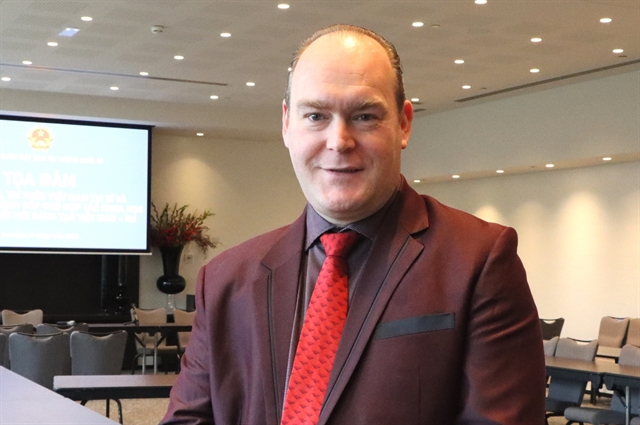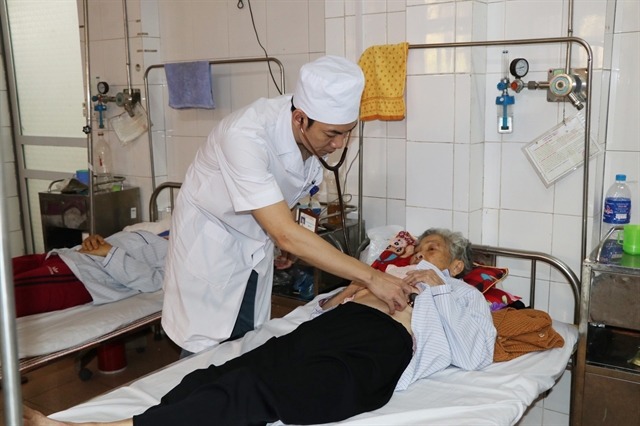 Opinion
Opinion

 |
| A doctor examines a patient at Trấn Yên District healthcare centre, Yên Bái Province. — VNA/VNS Photo Ngọc Anh |
Associate Professor, Dr. Phan Lê Thu Hằng, deputy director of the Department of Financial Planning and director of the Project Management Board for Construction Investment and Development of the grassroots health system, Ministry of Health, spoke to media about Party Central Committee Secretariat's Directive 25/CT-TW on continuing to consolidate and improve the quality of grassroots healthcare in the new context.
Can you please provide the background and reasons behind issuing Directive 25/CT-TW, issued on October 25, aimed at further strengthening, refining, and improving the quality of healthcare services at the grassroots level in the new context?
Over the course of two decades, the implementation of Directive 06-CT/TW aimed at strengthening grassroots healthcare has yielded remarkable outcomes. The extensive network of grassroots healthcare facilities has expanded across the country, undergoing progressive enhancements in physical infrastructure, equipment, human resources, and operational efficiency. It can be affirmed that the most significant achievements of the Vietnamese healthcare system are closely linked to the efforts of the grassroots healthcare network. Notably, the grassroots healthcare network has played a pivotal role in elevating Việt Nam's basic health indicators above those of nations sharing comparable income levels.
However, this network still grapples with numerous challenges. Its organisational structure is unstable, and it lacks the capacity to deliver healthcare services effectively, especially during emergency situations like disease outbreaks. The quality of services provided remains subpar, and there are deficiencies in terms of investment resources, physical infrastructure, equipment, medications, and medical supplies.
Moreover, the policies and renumeration for healthcare personnel are insufficient, making it difficult to attract highly qualified medical professionals committed to long-term service in grassroots healthcare. Disease prevention, health promotion, population health management, early disease detection, and disease control efforts still face limitations. A lack of public trust in service quality leads to patients bypassing lower-level facilities, causing an overwhelming burden on higher level hospitals.
Furthermore, the increasing and diverse healthcare needs of the population pose a significant challenge. The healthcare system is confronted with many issues, including the rapid aging of the population, shifting disease patterns, the prevalence of non-communicable diseases, and the increasing threat of emerging diseases.
Additionally, the adverse effects of climate change, industrialisation, and urbanisation on public health cannot be overlooked. Investing in strengthening the capacity of grassroots healthcare, which excels in providing extensive coverage, ensuring equity, and maintaining cost-effectiveness, is regarded as a prudent strategy for tackling these challenges.
Therefore, the development and issuance of a new directive to further strengthen, and improve the quality of grassroots healthcare in the new context is very important.
What are the significant new points in Directive 25/CT-TW?
The recent directive issued by the Party Central Committee’s Secretariat introduces several key elements.
First, the directive places a clear emphasis on the leadership priorities and guidance for grassroots healthcare. It stresses the necessity to enhance the awareness and responsibilities of party committees, government bodies, and the political system in enhancing awareness and responsibility. It also stresses monitoring and accountability.
Second, the directive underlines coordinated efforts among agencies and organisations in shaping strategies, policies, and laws for grassroots healthcare, recognising the importance of cross-sectoral actions to address health risk factors.
Third, the scope of grassroots healthcare is expanded to include various facilities and encourage private participation to provide primary and preventive healthcare.
Fourth, it underscores the need to standardise the organisation and management of district-level healthcare centres, allowing flexibility in response to local needs.
Fifth, the directive stresses the importance of increased investment in grassroots healthcare, aligning with innovative financial mechanisms for sustainable funding.
Sixth, the directive highlights the imperative of enhancing the quality of grassroots healthcare personnel through training policies, salary structures, and attracting qualified individuals.
Last, it emphasises innovation in healthcare operations with a focus on disease prevention, health enhancement, and the use of technology to transform healthcare delivery and enhance community interaction.
How is the financial mechanism for grassroots healthcare renewed as stipulated in the directive?
The reforms in healthcare financing for local communities are driven by several core principles.
There's a strong emphasis on the pivotal role of the state in ensuring financial resources for grassroots healthcare and preventive healthcare. To optimise the delivery of primary healthcare services and make the most of available financial resources, a flexible approach is being adopted. This includes adjusting service pricing, refining the list of services that health insurance covers, and optimising payment methods.
In more concrete terms, these changes involve revamping how budgets are allocated. The funding for local healthcare is being increased based on performance and practical conditions.
Primary healthcare providers are assigned tasks related to essential healthcare services. This approach also encourages the provision of primary healthcare services and community health management.
Furthermore, there's a focus on bolstering resources for preventive healthcare, early disease screening, and detection.
Improvements in the pricing of medical examination and treatment services covered by health insurance aim to ensure accuracy, sufficiency, and clarity of healthcare service pricing policies and welfare policies.
Continuous research is conducted to gradually increase health insurance contributions in line with the state budget and people's payment capabilities. Step by step, the scope of services provided by grassroots healthcare, covered by health insurance funds, is expanded to align with the contribution levels.
Can you please explain the role of local authorities in implementing primary healthcare policies?
Effective implementation of grassroots healthcare needs a close partnership between the Ministry of Health and local authorities.
The Ministry of Health primarily serves as a supportive entity, aiming to establish policy frameworks that enhance, refine, and advance primary healthcare. This involves establishing a system of professional guidelines related to primary healthcare and mobilising financial and technical resources to supplement and support localities, especially those facing challenges in carrying out activities to reinforce and enhance grassroots healthcare.
The successful implementation of primary healthcare policies largely relies on the active and proactive involvement of local authorities, including party committees, government organisations, the political system, and the local community. — VNS




